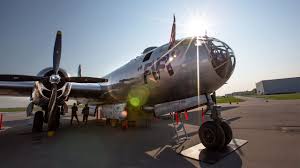The Boeing B-29 was the most advanced bomber of World War Two, and more expensive to design and build than the atomic bombs it dropped. It also helped influence the airliners we fly on today.
It was two years before Japan’s attack on Pearl Harbour dragged the United States into the war. But the US Army Air Corps was looking for a new bomber aircraft. What they were after was a “superbomber”, capable of flying up to 2,000 miles (3,200km) at a time and at altitudes never achieved before.
The aircraft they got would go on to drop the atomic bombs on Hiroshima and Nagasaki and ultimately bring an end to World War Two. It would also pave the way for a civil aviation boom that led to the everyday air travel we have today.
This is the story of how an aircraft that cost more than the entire Manhattan project – the B-29 Superfortress – changed the world.
It was January 1940 when the US Army Air Corps (USAAC) approached five American aircraft companies with the request to build a bomber bigger than anything the world had ever seen. Although the US was yet to enter the Second World War, in Europe it was already raging: Nazi Germany and the Soviet Union had only months earlier invaded Poland and divided it between them. The US knew it was a matter of time before it might be dragged in.
The aircraft the USAAC wanted would have to fly further and higher than any aircraft that had yet been built. That turned out to be an enormous challenge, even for the world’s biggest industrial nation.
Two of the companies approached, Douglas and Lockheed, soon abandoned work on their submissions due to the problem it posed. Boeing, however, had a head start, having begun work on a design as a private project a few years earlier.
A budget-busting bomber
Boeing’s XB-29 design eventually won the USAAC’s competition, but it would be another four years before the aircraft that became known as the B-29 Superfortress entered service.
It was the most expensive and complex industrial project US industry had ever undertaken and would not be surpassed until the space programmes in the 1950s and 1960s. And it pushed aviation technology almost to the limit.
The B-29 project became the most expensive of the entire war – costing nearly 50% more than the Manhattan Project that built the world’s first atomic bombs. In today’s money the aircraft, from design to completion, cost the equivalent of $55.6bn (£41.2bn).
The bombers that Boeing and other plane makers built for the first few years of World War Two tended to carry out their missions above 20,000ft (6km). The higher you fly, the longer you can fly, because the air is less dense, but it presented the crews inside the planes with many challenges.
The high speed of attacking planes in World War Two meant gunners often only had a split second to pick a target
“You have to be on oxygen the whole time,” says Hattie Hearn, the curator of the American Air Museum in Duxford in the UK. “Within two minutes of not being on oxygen you probably lose consciousness, and that was a real common thing that air crew had to had to consider. They had to have electrically heated flying suits, all this other gear which is going to be impeding movement. Very cumbersome, if you had to escape, for example. Often you could get too hot, and then that would again impede how you operated, if you’re sweating, and then suddenly that sweat freezes.”
Conditions were bad enough at 20,000ft. At 30,000ft, the height the B-29 needed to fly, they would be even worse.
Source: BBC


Comments are closed.